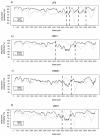Recombination in feline immunodeficiency virus genomes from naturally infected cougars
- PMID: 17445856
- PMCID: PMC1934564
- DOI: 10.1016/j.virol.2007.03.023
Recombination in feline immunodeficiency virus genomes from naturally infected cougars
Abstract
Recombination contributes significantly to diversity within virus populations and ultimately to viral evolution. Here we use a recently developed statistical test to perform exploratory analysis of recombination in fourteen feline immunodeficiency virus (FIVpco) genomes derived from a wild population of cougars. We use both the global and local Phi statistical test as an overall guide to predict where recombination may have occurred. Further analyses, including similarity plots and phylogenetic incongruence tests, confirmed that three FIVpco lineages were derived from recombinant events. Interestingly, the regions of mosaic origin were clustered in the area encoding lentiviral accessory genes and largely spared the viral structural genes. Because some of the mosaic strains are currently geographically disparate, our data indicate that the dispersal of cougars infected with these strains was preceded by recombination events. These results suggest that recombination has played an important role in the evolution of FIVpco for this wild population of cougars.
Figures






Similar articles
-
Evolution of the long terminal repeat and accessory genes of feline immunodeficiency virus genomes from naturally infected cougars.Virology. 2008 Jan 5;370(1):55-62. doi: 10.1016/j.virol.2007.08.024. Epub 2007 Sep 29. Virology. 2008. PMID: 17904608 Free PMC article.
-
Quantification of Feline immunodeficiency virus (FIVpco) in peripheral blood mononuclear cells, lymph nodes and plasma of naturally infected cougars.J Gen Virol. 2006 Apr;87(Pt 4):967-975. doi: 10.1099/vir.0.81450-0. J Gen Virol. 2006. PMID: 16528047
-
The molecular biology and evolution of feline immunodeficiency viruses of cougars.Vet Immunol Immunopathol. 2008 May 15;123(1-2):154-8. doi: 10.1016/j.vetimm.2008.01.022. Epub 2008 Jan 19. Vet Immunol Immunopathol. 2008. PMID: 18295904 Free PMC article. Review.
-
Epidemiology, genetic diversity, and evolution of endemic feline immunodeficiency virus in a population of wild cougars.J Virol. 2003 Sep;77(17):9578-89. doi: 10.1128/jvi.77.17.9578-9589.2003. J Virol. 2003. PMID: 12915571 Free PMC article.
-
FIV cross-species transmission: an evolutionary prospective.Vet Immunol Immunopathol. 2008 May 15;123(1-2):159-66. doi: 10.1016/j.vetimm.2008.01.023. Epub 2008 Jan 19. Vet Immunol Immunopathol. 2008. PMID: 18299153 Free PMC article. Review.
Cited by
-
New World feline APOBEC3 potently controls inter-genus lentiviral transmission.Retrovirology. 2018 Apr 10;15(1):31. doi: 10.1186/s12977-018-0414-5. Retrovirology. 2018. PMID: 29636069 Free PMC article.
-
Isolation and identification of a novel rabies virus lineage in China with natural recombinant nucleoprotein gene.PLoS One. 2012;7(12):e49992. doi: 10.1371/journal.pone.0049992. Epub 2012 Dec 4. PLoS One. 2012. PMID: 23226506 Free PMC article.
-
The secondary structure of the 5' end of the FIV genome reveals a long-range interaction between R/U5 and gag sequences, and a large, stable stem-loop.RNA. 2008 Dec;14(12):2597-608. doi: 10.1261/rna.1284908. Epub 2008 Oct 30. RNA. 2008. PMID: 18974279 Free PMC article.
-
Evolution of the long terminal repeat and accessory genes of feline immunodeficiency virus genomes from naturally infected cougars.Virology. 2008 Jan 5;370(1):55-62. doi: 10.1016/j.virol.2007.08.024. Epub 2007 Sep 29. Virology. 2008. PMID: 17904608 Free PMC article.
-
The effect of vaccination on the evolution and population dynamics of avian paramyxovirus-1.PLoS Pathog. 2010 Apr 22;6(4):e1000872. doi: 10.1371/journal.ppat.1000872. PLoS Pathog. 2010. PMID: 20421950 Free PMC article.
References
-
- Apetrei C, Robertson DL, Marx PA. The history of SIVS and AIDS: epidemiology, phylogeny and biology of isolates from naturally SIV infected non-human primates (NHP) in Africa. Front Biosci. 2004;9:225–54. - PubMed
-
- Awadalla P. The Evolutionary Genomics Of Pathogen Recombination. Nature Reviews Genetics. 2003;4(1):50–60. - PubMed
-
- Biek R, Drummond AJ, Poss M. A Virus Reveals Population Structure and Recent Demographic History of Its Carnivore Host. Science. 2006;311(5760):538–541. - PubMed
Publication types
MeSH terms
Grants and funding
LinkOut - more resources
Full Text Sources

